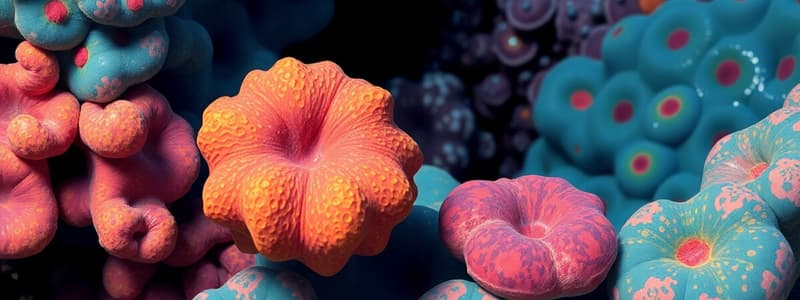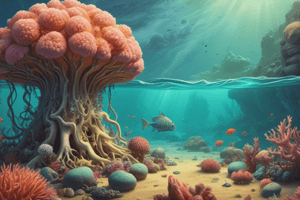Podcast
Questions and Answers
What is the primary function of the choanocytes in sponges?
What is the primary function of the choanocytes in sponges?
- Providing structural support
- Acting as a defense mechanism
- Facilitating reproduction
- Creating water currents for feeding and gas exchange (correct)
Which material can spicules in sponges be made of?
Which material can spicules in sponges be made of?
- Chitin
- Silica or calcium carbonate (correct)
- Collagen only
- Keratin
What type of feeding mechanism is most common in sponges?
What type of feeding mechanism is most common in sponges?
- Parasitic feeding
- Photosynthetic feeding
- Filter feeding (correct)
- Predatory feeding
How do sponges typically reproduce asexually?
How do sponges typically reproduce asexually?
What unique characteristic does spongin provide to sponges?
What unique characteristic does spongin provide to sponges?
Which of the following statements about sponge defenses is true?
Which of the following statements about sponge defenses is true?
In sponge reproductive methods, which of the following describes internal fertilization?
In sponge reproductive methods, which of the following describes internal fertilization?
Which sponge is known for providing medicinal compounds, including those for treating COVID-19?
Which sponge is known for providing medicinal compounds, including those for treating COVID-19?
Which class of sponges is characterized by having spicules composed of silica and being six-rayed?
Which class of sponges is characterized by having spicules composed of silica and being six-rayed?
What is the primary composition of spicules in the class Demospongiae?
What is the primary composition of spicules in the class Demospongiae?
Which characteristic is true about sponges in the class Hexactinellida?
Which characteristic is true about sponges in the class Hexactinellida?
Which type of skeleton is associated with Calcarea sponges?
Which type of skeleton is associated with Calcarea sponges?
What is a common feature of sponges classified as Homoscleromorpha?
What is a common feature of sponges classified as Homoscleromorpha?
Which type of body form is commonly found in Hexactinellida sponges?
Which type of body form is commonly found in Hexactinellida sponges?
What percentage of extant sponges is represented by the class Demospongiae?
What percentage of extant sponges is represented by the class Demospongiae?
What is a significant aspect that warrants further research regarding sponge development?
What is a significant aspect that warrants further research regarding sponge development?
Flashcards
Porifera aquiferous system
Porifera aquiferous system
A system of channels and chambers in sponges that facilitate feeding, gas exchange, and waste removal.
Sponge skeletal support
Sponge skeletal support
Sponges can have support from spicules (siliceous or calcium carbonate) or spongin (a unique collagen).
Sponge cell types
Sponge cell types
Sponges contain diverse cell types that exhibit flexibility in their roles.
Sponge reproduction types
Sponge reproduction types
Signup and view all the flashcards
Sponge feeding
Sponge feeding
Signup and view all the flashcards
Sponge defenses
Sponge defenses
Signup and view all the flashcards
Sponge diversity
Sponge diversity
Signup and view all the flashcards
Sponge regeneration
Sponge regeneration
Signup and view all the flashcards
What are glass sponges made of?
What are glass sponges made of?
Signup and view all the flashcards
What is a syncytial epithelium?
What is a syncytial epithelium?
Signup and view all the flashcards
What is a Trichimella larva?
What is a Trichimella larva?
Signup and view all the flashcards
What is the defining characteristic of Demospongiae?
What is the defining characteristic of Demospongiae?
Signup and view all the flashcards
Why are Demospongiae so diverse?
Why are Demospongiae so diverse?
Signup and view all the flashcards
What is a leucon body form?
What is a leucon body form?
Signup and view all the flashcards
What is the sponge-shrimp symbiosis?
What is the sponge-shrimp symbiosis?
Signup and view all the flashcards
Why are Calcarea important in sponge evolution?
Why are Calcarea important in sponge evolution?
Signup and view all the flashcards
Study Notes
Phylum Porifera
- Porifera is the phylum of sponges
- Sponges are multicellular animals
- They are asymmetrical mostly but some have a distinct apical-basal polarity
- Larvae are usually anterior-posterior
- Cells have adherens junctions, no gap junctions
- Suspension feeders
- Water is drawn through canals and chambers by choanocytes
- Adults are sessile (sedentary)
- Larval stages are usually motile and lecithotrophic
- The middle layer is variable, includes motile cells, and often skeletal material
- Skeletal elements can be calcium carbonate and/or silicon dioxide (spicules), or collagen fibers ("spongin")
- Neurons are absent
- Osculum is the only true sense organ, detects water flow rate
- Some larvae have biciliated cells (possible defective cell division product).
Sponge Structure
- Aquiferous system powered by choanocytes
- This system is for feeding, gas exchange, and waste expulsion
- Pinacoderm (outer surface of the sponge) is made of pinacocytes
- Mesohyl is between the dermal layers and may contain spicules, amebocytes, etc.
- Choanoderm is an inner layer of choanocytes creating water currents.
- Osculum - the opening
Sponge Body Forms
- Ascon, sycon, and leucon are differing body forms in sponges
- Ascon has simple/tubular body plan
- Sycon has a more complex body plan with multiple channels
- Leucon has the most complex structure with folded chambers.
Skeletal Support
- Sponges can be supported by spicules or collagen
- Spicules can be siliceous or calcium carbonate
- "Spongin" is a unique type of collagen
- Spicule composition and shape are crucial for classifying sponge species.
Spicule Diversity
- Spicules come in a variety of shapes and sizes
- They are made of silica (or glass) and/or calcium carbonate.
Cell Type Flexibility in Sponges
- Choanocytes, archaeocytes, and pinacocytes can transform into each other
- Flexibility allows for regeneration
Sponge Regeneration
- Sponges have a strong regenerative capacity
Sponge Feeding
- Most sponges are filter feeders
Sponge Predation
- Some sponges are predatory
Sponge Location
- Some sponges live in trees
- Many sponges are aquatic
Sponge Role in Trophic Levels
- Sponges play a role in cycling organic matter to higher trophic levels
Sponge Defenses
- Sponges have mechanical defenses (spicules) and chemical defenses.
- Some compounds in sponges have medicinal properties.
Sponge Reproduction
- Sponges can reproduce asexually (fragmentation)
- They can reproduce sexually via external fertilization (release of sperm and egg into the water) and oviparity (egg develops outside the sponge). Other sponges have internal fertilization and viviparity.
Diversity of Developmental and Larval Forms
- Sponge larval forms have different developmental patterns.
- These developmental patterns are not always homologous to other animal groups.
- Some developmental processes in sponges are controversial.
Phylogeny of Sponges
- The evolutionary relationships among sponge classes (Hexactinellida, Demospongiae, Homoscleromorpha, Calcarea) is shown via a branching diagram.
- There may be simplification in the phylogenetic relationships.
Class Hexactinellida
- Spicules are composed of silica (glass), six-rayed, and often fused into a lattice or cup shape.
- Found in deep water.
Class Demospongiae
- Over 80% of extant sponges.
- Usually vibrant colors (due to the presence of pigments)
- Skeletons include spicules, spongin, or both.
- May have a leucon body form.
- Can be up to 1m in height and diameter.
Class Homoscleromorpha
- Anatomically simple, often encrusting or forming leuconoid bodies.
- Spicules are small, simple, or absent.
- Found in shallow to deep waters.
Class Calcarea
- Spicules are composed of calcium carbonate.
- Spicules typically have three or four rays.
- Found in both leucon, sycon, and ascon body forms.
- All marine.
Glass Sponge - Shrimp Symbiosis
- Glass sponges harbor shrimp in symbiosis.
- Shrimp are too large to leave once the symbiosis has been established.
Studying That Suits You
Use AI to generate personalized quizzes and flashcards to suit your learning preferences.




